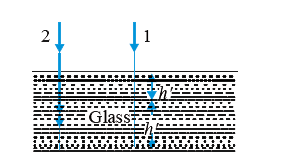A ray of light incident at the ................... (focus/pole) is reflected at the same angle with the principal axis
To solve the question, we need to determine whether the correct term to fill in the blank is "focus" or "pole" based on the behavior of light rays when they reflect off a mirror.
1. Understanding the Terms:
- Focus: The point where parallel rays of light either converge or appear to diverge after reflection.
- Pole: The point on the mirror's surface where the principal axis intersects the mirror.
2. Analyzing the Incident Ray:
- When a ray of light strikes the mirror at the pole, it reflects according to the law of reflection, which states that the angle of incidence is equal to the angle of reflection.
3. Reflection at the Pole:
- If a ray of light is incident at the pole, it will reflect off the mirror making the same angle with the principal axis as it did upon incidence. This means that the reflected ray will maintain its angle relative to the principal axis.
4. Reflection at the Focus:
- If a ray of light is incident at the focus, it will not reflect back at the same angle with respect to the principal axis. Instead, it will reflect parallel to the principal axis, which is a different behavior.
5. Conclusion:
- Since the question states that the ray of light is reflected at the same angle with the principal axis, the correct term to fill in the blank is "pole". Thus, the complete statement is: "A ray of light incident at the pole is reflected at the same angle with the principal axis."
Final Answer:
A ray of light incident at the pole is reflected at the same angle with the principal axis.
---
- Focus: The point where parallel rays of light either converge or appear to diverge after reflection.
- Pole: The point on the mirror's surface where the principal axis intersects the mirror.
- When a ray of light strikes the mirror at the pole, it reflects according to the law of reflection, which states that the angle of incidence is equal to the angle of reflection.
- If a ray of light is incident at the pole, it will reflect off the mirror making the same angle with the principal axis as it did upon incidence. This means that the reflected ray will maintain its angle relative to the principal axis.
- If a ray of light is incident at the focus, it will not reflect back at the same angle with respect to the principal axis. Instead, it will reflect parallel to the principal axis, which is a different behavior.
- Since the question states that the ray of light is reflected at the same angle with the principal axis, the correct term to fill in the blank is "pole". Thus, the complete statement is: "A ray of light incident at the pole is reflected at the same angle with the principal axis."
A ray of light incident at the pole is reflected at the same angle with the principal axis.
Similar Questions
A ray of light incident at the pole at angle 25∘ will be reflected at an angle 25∘
View SolutionA ray of light is incident on a concave mirror . It is parallel to the principal axis and its height from principal axis is equal to the focal length of the mirror. The ratio of the distance of point B to the distance of the focus from the centre of curvature is (AB is the reflected ray)
_E01_055_Q01.png)
View SolutionThe ray of light that bounces off the mirror is called ................... incident ray/ reflected ray)
View SolutionThe polarizing angle of glass is 57∘ . A ray of light which is incident at this light which is incident at this angle will have an angle of refraction as
View SolutionIf an incident ray passes through the focus, the reflected ray will
View SolutionA mirror is inclined at an angle of θ with the horizontal. If a ray light is incident at an angle θ as shown , then the angle made by reflected ray with the horizontal is
_E01_002_Q01.png)
View SolutionA ray of light is incident on a transparent medium at polarizing angle. What is the angle between the reflected ray and the refracted ray .
View SolutionA ray of light-is incident on glass at the polarising angle ip. Find the angle between the reflected and refracted rays.
View SolutionA ray of light is incident at an angle i from denser to rare medium. The reflected and the refracted rays are mutually perpendicular. The angle of reflection and the angle of refraction are respectively r and r'. Then the critical angle will be:

View SolutionOn a plane mirror, a ray of light is incident at an angle of 30∘ with horizontal . To make the reflected ray vertical , at what angle with horizontal must a plane mirror be placed ?

View Solution
